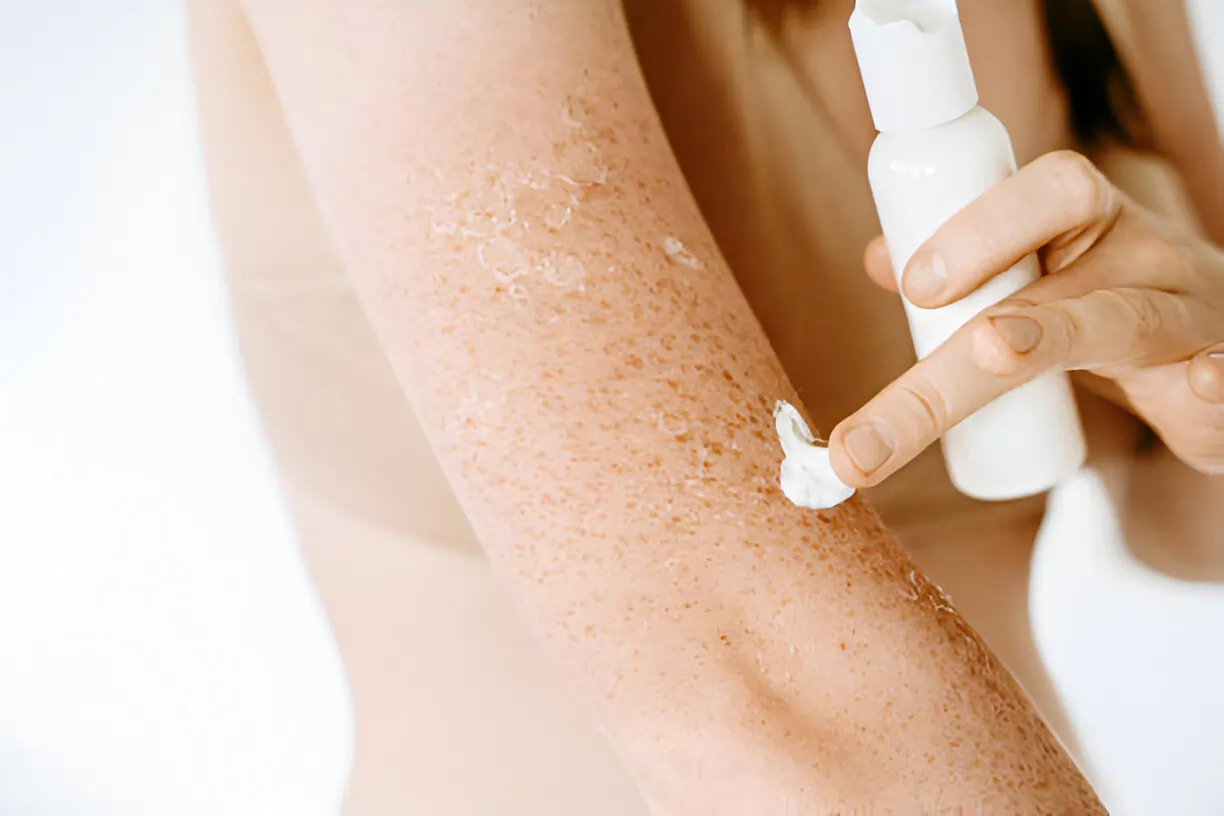If you’ve ever noticed small, rough bumps on the backs of your arms or thighs, you’re not alone. This harmless but frustrating skin condition is called keratosis pilaris (KP), and it affects up to 40% of adults. Fortunately, consistent skincare using a KP exfoliating lotion can significantly reduce its appearance and help restore smooth, healthy-looking skin.
In this guide, we’ll explore what KP is, what causes it, the ingredients that work best to treat it, and how to build an effective skincare routine around exfoliation.
What Is Keratosis Pilaris?
Keratosis pilaris is a common skin condition caused by excess keratin — a natural protein found in hair, nails, and skin. When keratin builds up, it clogs hair follicles, creating small, goosebump-like patches on the skin. These bumps are typically skin-colored or red and may feel dry, rough, or even itchy.
While it’s not dangerous or contagious, KP can affect a person’s confidence, especially when it appears on visible areas like the arms, legs, or cheeks.
Common Signs of KP Include:
- Dry, rough patches of skin
- Tiny, hard bumps (often mistaken for acne or rash)
- Itchiness or irritation (especially during dry weather)
- More prominent in colder months due to low humidity
KP tends to appear most frequently on:
- Upper arms
- Thighs
- Buttocks
- Cheeks
- Occasionally on calves and forearms
Why Exfoliation Is Essential for KP Treatment
Most traditional lotions or creams don’t treat KP effectively because they only hydrate the surface of the skin. KP is a result of dead skin cells and keratin clogging hair follicles — so the only real way to manage it is by exfoliating those blockages.
A KP exfoliating lotion is specifically formulated to:
- Dissolve keratin plugs inside hair follicles
- Remove the top layer of dead skin cells
- Hydrate the skin barrier to prevent recurrence
- Reduce redness, inflammation, and texture over time
What Makes a Good KP Exfoliating Lotion?
To choose the right product, you need a lotion that offers both exfoliation and moisture — the two pillars of KP management. The best ones combine chemical exfoliants with soothing, barrier-restoring ingredients.
✅ Must-Have Ingredients:
- Lactic Acid (AHA)
A gentle exfoliant that dissolves dead skin and hydrates. It’s often the most effective ingredient for KP. - Salicylic Acid (BHA)
Oil-soluble and able to penetrate deep into pores to unclog and calm inflamed follicles. - Urea (10% or higher)
A dual-action ingredient that exfoliates while softening thick, rough skin. Great for sensitive skin too. - Glycolic Acid
An AHA with smaller molecules that deeply exfoliate. Ideal for more severe texture but can be drying if overused. - Ceramides and Hyaluronic Acid
These restore the skin’s protective barrier and ensure moisture is retained after exfoliation. - Niacinamide (Vitamin B3)
A calming, anti-inflammatory agent that can reduce redness and blotchiness associated with KP.
Ingredients to Avoid in KP Lotions
While the focus is usually on what works, it’s equally important to avoid irritants that can make your condition worse and view website to know more:
- Artificial fragrances and dyes – These can lead to further irritation or allergic reactions.
- Alcohol-heavy formulas – Strips moisture from the skin, worsening dryness.
- Harsh physical scrubs – These can tear or damage skin, especially when used on sensitive areas.
How to Build a KP-Friendly Skincare Routine
An effective skincare routine doesn’t have to be complicated — it just needs to be consistent. Here’s how to structure it for maximum results:
🧼 Morning Routine:
- Cleanse gently with a non-drying body wash (look for KP-specific formulas).
- Apply a lightweight moisturizer with ceramides or hyaluronic acid.
- Use SPF on any exposed areas — UV rays can increase pigmentation and worsen inflammation.
🌙 Night Routine:
- Cleanse again if needed, especially after workouts.
- Apply a KP exfoliating lotion to problem areas while skin is slightly damp.
- Layer with a hydrating cream if your skin feels dry or sensitive.
Tip: Start using exfoliating lotion every other night and increase to daily use as tolerated.
Best Practices for Using a KP Exfoliating Lotion
To get the most benefit from your lotion, follow these simple but effective best practices:
- Apply after a warm shower – Pores are open and skin is more receptive.
- Use on clean, dry skin – No oils or sweat should be present on the surface.
- Do not over-exfoliate – Especially if you’re using other exfoliating acids or retinol elsewhere.
- Store properly – Keep products away from direct sunlight to preserve ingredient stability.
- Combine with a KP-friendly body wash – Using a coordinating product boosts results.
Lifestyle Changes That Help Reduce KP
In addition to topical treatments, certain lifestyle choices can improve or worsen keratosis pilaris. Here are some habits that help:
✔️ Do:
- Wear loose, breathable clothing
- Use a humidifier in dry weather
- Stay hydrated and eat a nutrient-rich diet (Vitamin A and E help)
- Pat dry with a towel — don’t rub vigorously
❌ Avoid:
- Hot, steamy showers that dry out your skin
- Tanning (sun exposure can worsen KP over time)
- Harsh scrubs or loofahs that can cause microtears
- Overuse of retinoids or acids without hydrating layers
When to Expect Results
With consistent use of a KP exfoliating lotion, most people begin to see improvement within 2–4 weeks. Skin texture becomes smoother, redness fades, and the “chicken skin” effect is noticeably reduced.
Severe cases may take longer — up to 2–3 months — to show dramatic change. For maintenance, many users find that applying a gentle exfoliating lotion 3–5 times a week keeps KP under control long-term.
Frequently Asked Questions (FAQ)
How often should I use a KP exfoliating lotion?
Start 2–3 times per week and build up to daily use as your skin adjusts.
Can I use a KP lotion on my face?
Some mild formulas with low AHA/BHA concentrations are safe for facial use, but always patch test first. Avoid applying near eyes or lips.
Is KP curable?
No, but it is highly manageable. Most people can reduce symptoms significantly with regular care.
Can I exfoliate and moisturize at the same time?
Yes! Many KP lotions are designed to do both. However, if you feel dry, layering a simple moisturizer over the exfoliant can help.
Final Thoughts
Managing keratosis pilaris doesn’t require an expensive or complex routine — just the right products and consistency. A high-quality KP exfoliating lotion with chemical exfoliants like lactic acid, urea, or salicylic acid can be the cornerstone of your treatment plan.
Backed by gentle cleansing, hydration, and lifestyle adjustments, this approach can deliver smoother, healthier-looking skin — and help you feel more confident in your body every day.
Read more: The Benefits of Integrating Cloud Fax API Into Your Communication Systems – Croudmomentum.com
Creative Exterior Updates: Insights from Residential Construction Pros – Croudmomentum.com
Pet Parasite Prevention Guide: Essential Tips for Pet Owners








